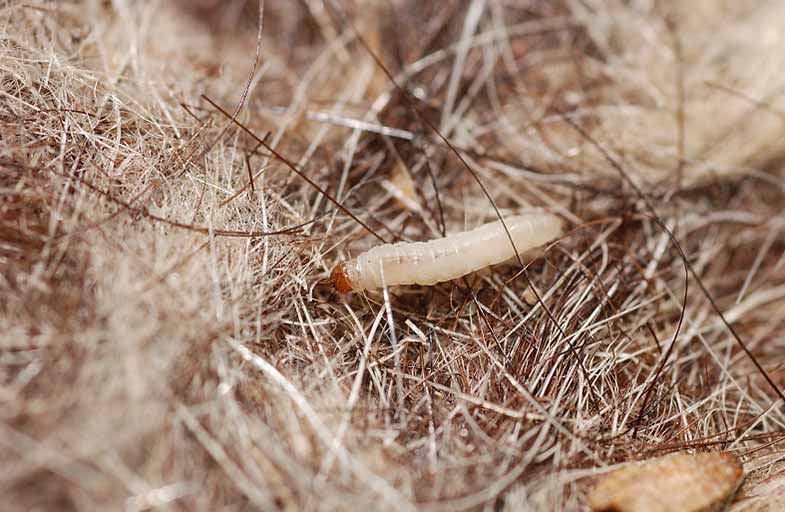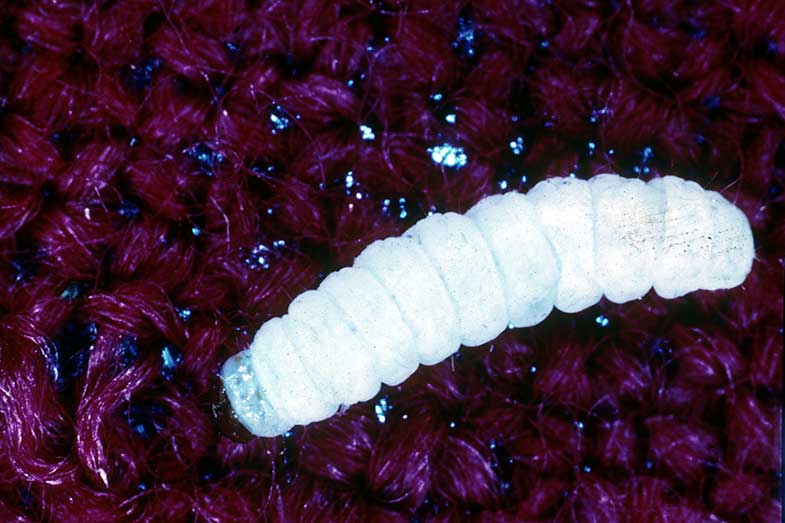How to Get Rid of Bed Worms
Disclosure: We may get commissions for purchases made through links in this post.
You may have heard of bed bugs infesting homes, but what about bed worms? These tiny insects in your bed may be moth larvae, a clothes moth specie that eats wool and other natural fibers. Female moths prefer to lay their eggs, ranging from 50 to 1000 eggs, in clothing and bedding as these places offer an adequate food supply during the moth’s larvae stage. So you may be wondering how to get rid of them.
Here are four tips on how to get rid of bed worms:
- Wash all of your bedclothes in hot water, and use high heat to dry.
- Freeze any items you can’t wash for two days.
- Thoroughly clean your entire bedroom by vacuuming, dusting, and wiping down surfaces with a store-bought cleaning solution, or vinegar and water.
- Call a pest control service.
Although cleaning everything can remove the bed worm infestation, having a pest control service go through your home can ensure their complete removal.

Are Bed Worms Dangerous?
Most bed worms (or moth larvae) are not interested in biting humans, but they may cause other forms of inconvenience. Moths lay cream-colored eggs that eventually hatch and grow to creamy-white larvae. While adult moths are harmless, their larvae survive on fabrics. Female moths prefer cotton and wools. Here are more detailed ways to remove bed worms.
How to Get Rid of Bed Worms
- Wash your bedclothes
Wash your bedding in hot water (about 130 degrees Fahrenheit) and use high heat in the drier, if possible. You may also want to inspect your linens and assess any damage by bed worms. - Freeze items you can’t wash
For things that can’t go in the wash, put them in the freezer for around two days. The freezing temperature is an excellent pesticide for removing bed worms. - Clean Your Entire Bedroom
Give your room a thorough cleaning. Vacuum, dust, and wipe down surfaces. Use eco-friendly cleaners or make your own solution with vinegar and water.
After vacuuming, remove the contents outside since it may be full of eggs. Use a carpet steamer for thicker carpets. You may also want to hire a dry cleaning company to handle the rug, and a regular cleaning company to do a full clean sweep.
Use a stiff brush to clean your mattress to remove all of the bed worms and their eggs. You can also place a small amount of baking soda on the mattress, leave it for a day, and vacuum it. - Call a Pest Control Company
For peace of mind, a pest control company can thoroughly check your bed and other areas for remaining larvae. If found, they will use thorough methods to remove them. They may also give you some tips to prevent an infestation in the future.
Find the Source of the Bed Worm Infestation

If hiring a pest control company is not an option, and you’ve followed the steps above to clean everything, next, you want to find the bed worm source.
- Moths usually draw to warm and dark locations. Don’t be surprised to find them in your closet, your fabrics, or the corner of your bed. Typically, moth and bed worm infestation starts in one part of your house and spreads slowly to other rooms.
- Try to identify where the moths are coming from and what attracts them to your home. Knowing what attracts these insects can help you find them before they start breeding and ruining your bed and other things in your home.
- Carefully go through all of your bedclothes, your regular clothes, and things around the room. Check for chew marks.
How to Prevent a Bed Worm Infestation
You may not find moths as serious threats to your home, but their worm-like larvae can ruin many things, including your bedclothes. Here are do-it-yourself bed worm remedies to get rid of bed worms and prevent moths from breeding and infesting your home again.
- Make your room a safe place to sleep. Moths love wools and linens, so these creatures prefer to lay and hatch in your bedroom. Vacuum both sides of the mattress and box springs to avoid the infestation. A handheld mattress vacuum (view on Amazon) will help you get rid of bed worms and other microorganisms.
- Routinely wash your beddings, comforters, and covers in hot water. Clean your items and carefully vacuum surfaces, including floors, furniture, and spaces under your beds.
Exterminating Bed Worms Fast
It can be difficult to eliminate bed worms, and you may want to try insect spray as a cheap, but a quick remedy. There are do-it-yourself moth repellents, including sprayers and traps that you can hang in wardrobes and cupboards to prevent female moths from attaching their eggs in fabrics.
Spray anywhere in your home that you think moths may be hiding. After spraying, use a steam machine (view on Amazon) to get in all of the gaps, mats, and bedroom furniture and mattresses.
Another quick way to get rid of bed worms, and possibly other unwanted insects in your home is to hire a professional pest control service. The existence of bed worms may mean that moths are all around your home, and it can be tough to remove them without pest control professionals.
Other Natural Bed Worm Prevention Options
Bed worm prevention is most effective with a quick and thorough treatment at the first sign of trouble. Don’t ignore their existence and quickly act once you see them. You don’t want to have damage caused to your things because you failed to protect yourself against an infestation. Here are some of the natural, but effective prevention remedies that don’t involve pesticides:
- Start by looking for damage in your clothing and other fabrics in your home. Check for webs and cocoons in the corners of your home. Signs of fabric damage will alert you to the location of the eggs.
- Moths can lay their eggs anywhere, which means you should not leave things unturned. The moth eggs and larvae may go unnoticed without an intentional inspection.
- Keep your room ventilated as female moths are more likely to attach their eggs in warm and humid places. A combination of sunlight exposure, brushing, and vacuuming is an effective way to combat moths and prevent them from laying eggs in your bed.
- You can free your home from moth infestation by being vigilant about vacuuming and cleaning. The Moosoo’s Powerful Cordless Vacuum (view on Amazon) offers an efficient way to pick up the larvae with its outstanding running time.
Bed Worm-Infested Mattresses
Female moths particularly like to lay eggs on fabrics, so it is not surprising to find moth larvae in beddings. Moth larvae can live on mattresses for several weeks before they turn into adult moths.
The moth’s full life cycle extends up to several months. Getting rid of bed worms means cleaning your entire home and conducting periodic treatments for an extended time to stop the infestation.
A thorough cleaning of your room means stripping the bed down. An essential step in bed worm elimination is to treat through the cracks and crevices in your bedroom. Apply natural insect pesticide to your room and perform the same treatment in other parts of your house.
Reasons Why You Should Get Rid of Bed Worms Immediately

- A sign of bed worm infestation means you have to move fast. These creatures can expose you and your family to skin allergies. The moth larva progresses through five stages, with each phase lasting to about two weeks. Failure to get rid of these creatures increases the chance of coming in contact with the larvae.
- The bed worms or moth larvae have stinging hairs that may lead to an irritating sensation. In some cases, these stinging hairs can cause skin swelling, dermatitis, and urticaria. Some people develop rashes that resemble a mild case of poison ivy that may last up to four days.
- Bed worms feed on fabrics. You may not be allergic to them, but they can still do a lot of damage to your bedclothes and your whole home.
- The bed worms develop into an adult moth, which can be annoying. The adult moth lay and glue their eggs on fabrics.
- The larva becomes a pupa by the end of the fifth phase of development, at which time it metamorphoses into a moth. Failure to get rid of these bed worms leads to a cycle, allowing them to cause further damage.
Where Do Bed Worms Come From?
Moths are attracted to carpets and clothing and prefer to lay eggs on fibers containing sweat and liquid spills. The female moth lay hundreds of eggs during its lifetime and carefully lay them in places where they can survive. Its larvae derive nourishment from natural fibers, which is the reason you find what you thought is bed worms on your mattress and bedding.
You will probably never see the moths and their larvae until there is already damage. Protect your fibers, clothing, and bedding by regular cleaning. You may also want to add a bed bug cover for your mattress, such as the SafeRest Premium Zippered Mattress Encasement (view on Amazon). It’s lab tested and certified bed bug proof. The SafeRest is also hypoallergenic, breathable, and vinyl free.
Clothes Moths
In contrast to other types of moths, clothes moths are seldom seen because they prefer dark areas. You can find them under the bed, in closets, basements, and other undisturbed areas such as seams and creases. Clothes moth adults do not damage the fabrics, but pinhead-sized eggs that hatch into larvae feed on fabrics.
Webbing Clothes Moth Larvae
The webbing clothes moth larvae create patches of webbing as they crawl over and feed on the infested materials. The casemaking clothes moth behaves differently as its larva encloses itself in an open-ended tubular case that it drags as it moves around the fabric.
It’s important to identify that it’s moth larvae and not a different type of insect, causing damage to your fabrics. Then you will be able to take the necessary steps to remove them. For instance, while carpet beetles are quite different in appearance, they are common in homes and share an appetite for similar fabrics as clothes moths.
Conclusion – How to Get Rid of Bed Worms
Bed worm infestation can damage your bedding, and the presence of these little creatures can be quite an inconvenience. You can get rid of bed worms through do-it-yourself remedies, such as cleaning, spraying, and sunning your fabrics.
You can also use chemical-free cleaning with a canister seam cleaner (view on Amazon) to eliminate bed worms and other insects around your home. These are some of the natural prevention options, though a faster way to get rid of bed worms is to hire a pest control professional. Utilizing this type of service will save you a lot of time and effort.






